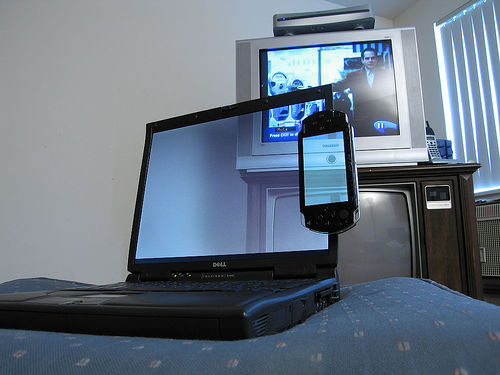I spent a fun couple of hours last week participating in a webinar hosted by Cynopsis Kids, entitled “Leveraging the Second Screen in the New Kids Market.” It was an interesting, fast-paced conversation with a four-person panel representing different sectors of the kids business, talking about what the second screen means for them and how they’re addressing the challenges and opportunities it represents. My presentation focused on the second screen as relates to younger kids. I’ve been thinking about the conversation we had for a few days now, and I wanted to share a few of the things that struck me, now that we’re all living in this multi-screen world.
Second Screen, or First?
In the course of my presentation, I shared one of my tried and true development caveats, “Don’t assume they know who you are.” I mentioned this in a prior post on branded games, but one of the things we frequently see is that, no matter how famous the property, children may not have been exposed to it before they experience it in an app or a web game. Which leads to a larger point — who’s to say that the phone or the computer is truly the second screen? How many kids now and in the coming years will have their first experiences with famous brands like Sesame Street, Busytown or Spider-Man in an app or through a YouTube clip? It’s sort of scary and wonderful all at once. We have so little control over where a child’s first interaction with content will be, but hopefully this gives us all good incentive to make products and properties that are universally welcoming and positive experiences, regardless of prior knowledge.
Properties, Properties Everywhere!
In a related vein, the group discussed the need for brands to be consistent across platforms. Given that you have no idea where a child or a parent is first going to encounter your property, taking care that each iteration both reflects and supports the others is critical. When I started in the kids business fifteen years ago, basically the only way things progressed was television show —> ancillary products (including digital, which largely consisted of CD-Roms, remember those?). Sure there occasions where it went more like book —> television show —> ancillary, but that’s about as wild as it got. Now we see properties popping up from every direction, establishing themselves first as toys, apps, web series, eBooks, even YouTube videos like Annoying Orange. This makes it all the more critical that we look at properties as content ecosystems, maximizing what they can do in each form of media, and making sure each place they appear is consistent with the others.
It Matters Who’s Watching
A lot of the talk these days about second screens tends to focus on simultaneous experiences. There are all of these phenomenal opportunities to give supplemental information in real time and encourage engagement and even do some marketing (gasp!), and it’s easy to forget that while we adults multi-task with relative ease, little kids are not developmentally in the same place. As part of my presentation, I cited some nice information from the PBS Parents Child Development Tracker, about how preschoolers are just learning to sustain focus. That means focusing on one thing, and even then it takes them some time to experience engagement. So when I think about preschoolers and the second screen, I think primarily about non-simultaneous experiences, ones that can support curriculum and engagement with a property before or after a television experience, but not at the same time.
It’s a Different Screen
Living in a world of super-enabled devices — my phone can practically make me a cup of coffee at this point — it’s easy to forget that each device is really tailored to different things, and that no one device gives us everything. We go to the television for a certain experience and we keep going there, as various research was shows that, despite the rise in second screen usage, television consumption remains fairly constant. We go to a phone or a tablet, generally speaking, to do something slightly different. The simple phrase that someone said during this discussion, “It’s not just a second screen, it’s a different screen,” has really stuck with me as it encapsulates the challenge we face moving content from one screen to another. (So thank you to whoever that was – webinars are not great for facial recognition!)
It’s All About Airports!
Last but not least, everyone seems to be making programming for airports these days. I have no idea what this means for the larger media landscape — other than I’m sure to be barraged with noise and glowing sets perched all around as I wait in the security line next week for my Easter vacation — but if someone could do something about the taxi TV programming while they’re at it, I’d really appreciate it!
Whatever screen you’re on, we’d be glad to see you and we’ll be all over the country in the coming weeks. So if you’d like to catch up, here are some options.
Carla will be at Game Developers Conference, San Francisco (March 25-29)
- GDC Microtalks: One Hour, Ten Talks, A Bazillion Ideas
- Guidelines for Great Mobile Games for Kids
- Child’s Play: Making Games for Kids Roundtable (If you’ve ever attended one of the breakfasts I arrange, we’ve made it a formal GDC event now!)
We’ll both be at Sandbox Summit, Boston (April 15-16)
- Carla: Apportunity Knocks: Science + Games = <3 <3 <3
- Anne: Play by the Book: Exploring classic stories in games
NYC: Anytime we’re not elsewhere
Twitter: @noCrusts
Email: KidsGotGame@NoCrusts.com





















